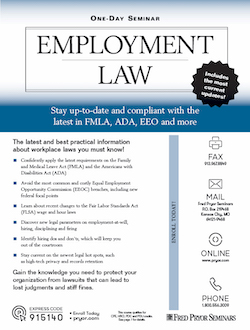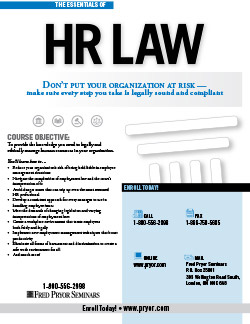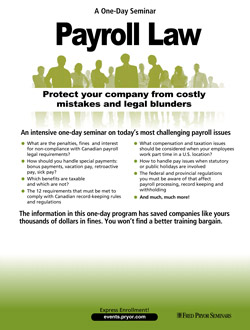Coronavirus in the Workplace: Key HR Issues
- Author: Lisa Smith
- Categories:
- Tags:
- Share on:
The spread of the novel coronavirus (COVID-19) has gone from a handwashing and elbow-bumping conversation to the most significant workplace issue we have ever seen. Employers are confronting dilemmas that change every day. Questions regarding how to handle emergency leave, workplace safety and health, furloughs, layoffs and mandated closing of businesses along-side all the other employment issues that will still be there waiting once this crisis comes to a close.
The following Frequently Asked Questions (FAQs) have been collected from employers across the country and are some of the more common problems that employers are currently facing. Employers are also encouraged to consult the Centers for Disease Control (CDC) and the Equal Employment Opportunity Commission (EEOC).
Q: Our business is suffering under the weight of this COVID-19 pandemic. We are trying to avoid layoffs and want to cut hours. Can we do this legally?
A: Yes. Most states have requirements that before wages or hours are cut a notice must be given. If you can provide at least a 7-day notice before making effective the new wage or schedule, you should be fine. However, there are some states that may require a longer notice. Many states with scheduling laws have suspended these requirements when the change is related to the pandemic. So, consulting your state labor board is recommended.
Q: Can I cut an overtime-exempt employee back to 2 days/week and cut the salary without violating their exempt status?
A: Maybe. Overtime exemptions are not based on hours worked. If the employee’s position qualifies for the exemption using the tests set out in the FLSA, then the employee may work as few hours as you prefer as long as the salary does not drop below $684 (in most states) and the primary duties do not become those commonly associated with non-exempt positions. If you wish to pay less than the required salary, the employee must be reclassified as non-exempt and if ever restored to a full schedule, overtime must be paid when more than 40 hours is worked in a 7-day workweek. Employers are cautioned not to reclassify the position because it benefits the employer and then reclassify again in a few months when again, the employer would receive the benefit.
Q: We want to close the business for a few weeks during the COVID-19 pandemic. Can we deny the use of PTO during this time that we will have no business income?
A: Possibly. Most states allow the employer to decide when accrued PTO can be used. In some states, the employee is allowed to use PTO if they have it available because it is viewed as wages in the bank, so to speak. There may also be emergency provisions in place right now. You will need to check with your state’s wage and hour department for full details.
Q: If we need to put some employees on a furlough without pay, how do we handle the health insurance premiums that normally come out of their checks?
A: Some employers will apply enough PTO to cover the premiums. If there is no PTO, an agreement must be made with the employee to pay their portion during the downtime. COBRA is an option for an employer with 20+ employees. Some states also offer a mini-COBRA option for employers with fewer than 20 employees.
Q: If we close for several weeks, can our employees draw unemployment?
A: Most likely, yes. Most states are waiving some of the usual requirements and providing emergency unemployment payments to workers displaced by the COVID-19 pandemic.
Q: What is happening with H.R.6201 – Families First Coronavirus Response Act?
A: As of the date of this post, the Senate has not finished reviewing and debating amendments to House Bill 6201. Once the Senate passes the Bill, it will go to President Trump for a signature. Once signed, an effective date will be announced.
Q: We have an employee who traveled out of state and will return on Monday. Can we ask where they traveled and if they could have been exposed to COVID-19 before we allow them to return?
A: Employers may not make disability-related inquiries or require medical examinations (like taking a temperature) unless (1) the employer can show that the inquiry or exam is job-related and consistent with business necessity, or (2) the employer has a reasonable belief that the employee poses a “direct threat” to the health or safety of the individual or others that cannot otherwise be eliminated or reduced by reasonable accommodation.
Determining if an outbreak has risen to the level of a “direct threat” is based on the severity of the illness. During a pandemic, an employer is not required to wait until an employee shows symptoms before requesting information about possible exposure to a pandemic like COVID-19. If the CDC or any government health official recommends that people who visit specified locations self-isolate upon return, an employer may ask an employee what locations they visited.
Choose a Seminar and Save $10
HR's Role in COVID-19, How Human Resources is Establishing the New Normal
Half Day
- CEU: 0.3
Team Training - Virtual or In-person
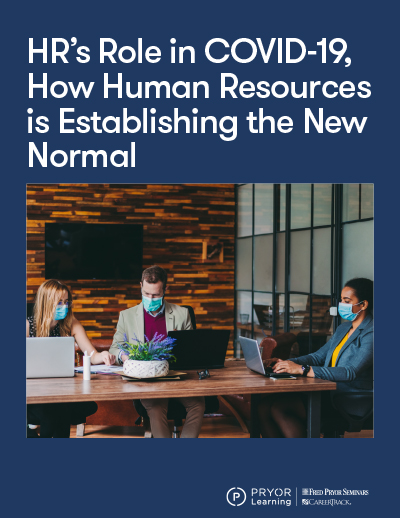
Sexual Harassment & Bullying in the Workplace
1 Day
- CEU: 0.6
- CPE: 6
Team Training - Virtual or In-person
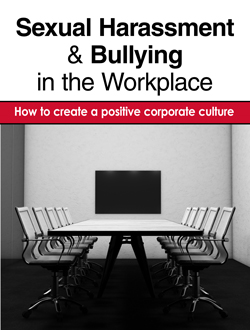
Human Resources for Anyone with Newly Assigned HR Responsibilities
1 Day
- CEU: 0.6
- CPE: 6
- HRCI: 5.5
- PDC: 6
Virtual Seminars:
-
Apr 17
-
Apr 22
-
Apr 23
-
+ 32 more dates
In-Person Events:
- Jul 7, Denver, CO
- Jul 17, Troy, MI
-
+ 2 more dates
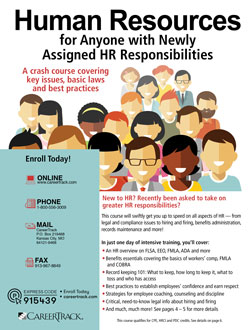
Training the Trainer
1 Day
- CEU: 0.6
- CPE: 6
Virtual Seminars:
-
Apr 18
-
Apr 24
-
Apr 29
-
+ 15 more dates

The Essentials of HR Law
1 Day
- CEU: 0.6
- CPE: 6
- HRCI: 5.5
- PDC: 6
Virtual Seminars:
-
Apr 22
-
Apr 24
-
Apr 30
-
+ 24 more dates
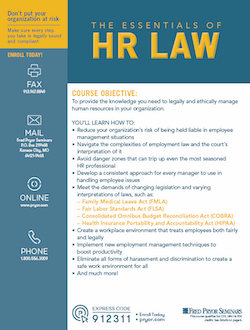
Payroll Law
1 Day
- CEU: 0.6
- CPE: 6
- HRCI: 5.5
- PDC: 6
Virtual Seminars:
-
Apr 17
-
Apr 23
-
Apr 25
-
+ 26 more dates
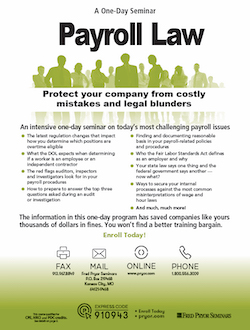
FMLA Compliance
1 Day
- CEU: 0.6
- CPE: 6
- HRCI: 5.5
- PDC: 6
Virtual Seminars:
-
Apr 17
-
Apr 28
-
May 7
-
+ 15 more dates
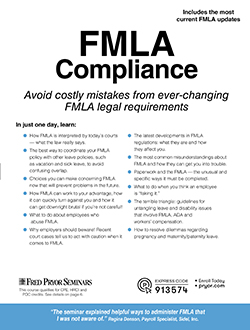
One-Person HR Department
Half Day
- CEU: 0.3
- HRCI: 3
- PDC: 3
Virtual Seminars:
-
Apr 22
-
Apr 22
-
Apr 24
-
+ 37 more dates

Comprehensive Training for HR Managers (2-Day)
2 Days
- CEU: 1.2
- CPE: 12
- HRCI: 11
- PDC: 12
Virtual Seminars:
-
Apr 23-24
-
Apr 28-29
-
May 1-2
-
+ 20 more dates

Workers' Comp
1 Day
- CEU: 0.6
- CPE: 6
- HRCI: 5.5
- PDC: 6
Virtual Seminars:
-
Apr 23
-
May 2
-
May 7
-
+ 3 more dates

Learn to Write Effective Policies & Procedures
1 Day
- CEU: 0.6
- CPE: 6
Virtual Seminars:
-
May 5
-
May 16
-
May 22
-
+ 5 more dates

Employment Law
1 Day
- CEU: 0.6
- CPE: 6
- HRCI: 5.5
- PDC: 6
Virtual Seminars:
-
May 6
-
May 7
-
May 15
-
+ 5 more dates
